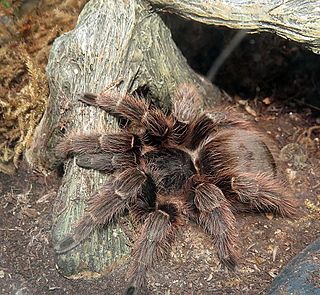
The plains zebra, also known as the common zebra, is the most common and geographically widespread species of zebra. Its range is fragmented, but spans much of southern and eastern Africa south of the Sahara. Six or seven subspecies have been recognised, including the extinct quagga which was thought to be a separate species. More recent research supports variations in zebra populations being clines rather than subspecies.

The Tarantula Nebula is a large H II region in the Large Magellanic Cloud (LMC), forming its south-east corner.

Wasps in the family Pompilidae are commonly called spider wasps, spider-hunting wasps, or pompilid wasps. The family is cosmopolitan, with some 5,000 species in six subfamilies. Nearly all species are solitary, and most capture and paralyze prey, though members of the subfamily Ceropalinae are kleptoparasites of other pompilids, or ectoparasitoids of living spiders.

A spinneret is a silk-spinning organ of a spider or the larva of an insect. Some adult insects also have spinnerets, such as those borne on the forelegs of Embioptera. Spinnerets are usually on the underside of a spider's opisthosoma, and are typically segmented. While most spiders have six spinnerets, some have two, four, or eight. They can move both independently and in concert.

A zebroid is the offspring of any cross between a zebra and any other equine to create a hybrid. In most cases, the sire is a zebra stallion. Offspring of a donkey sire and zebra dam are called a donkra and offspring of a horse sire and a zebra dam called a hebra do exist, but are rare and are usually sterile. Zebroids have been bred since the 19th century. Charles Darwin noted several zebra hybrids in his works.

Abbey Road is a thoroughfare in the borough of Camden and the City of Westminster in London running roughly northwest to southeast through St John's Wood near Lord's Cricket Ground. It is part of the road B507. This road is best known for the Abbey Road Studios and for featuring on the cover of The Beatles’

The Goliath birdeater belongs to the tarantula family Theraphosidae. Found in northern South America, it is the largest spider in the world by mass – 175 g (6.2 oz) – and body length – up to 13 cm (5.1 in) – but it is second to the giant huntsman spider by leg span. It is also called the Goliath bird-eating spider; the practice of calling theraphosids "bird-eating" derives from an early 18th-century copper engraving by Maria Sibylla Merian that shows one eating a hummingbird. Despite the spider's name, it rarely preys on birds.

Avicularia is a genus of the family Theraphosidae containing various species of arboreal tarantulas. The genus is native to tropical Central and South America. Each species in the genus has very distinguishable pink foot pads.

The Brazilian whiteknee tarantula is a species of tarantula from Brazil that is commonly kept as a pet.

Lasiodora parahybana, the Brazilian salmon pink bird-eating tarantula, also simply known as the salmon pink or LP, is a tarantula from north-eastern Brazil and considered to be the fourth largest tarantula in the world.

The Antilles pinktoe tarantula, also known as the Martinique red tree spider or the Martinique pinktoe is popular as a spider pet because of its docile character and unique coloration.

One of the larger species of tarantula, the Chaco golden knee, formerly known as Grammostola aureostriata, can be expected to reach between 20 and 22 cm (8.5 in).

Fried spider is a regional snack in Cambodia. In the Cambodian town of Skuon, the vending of fried spiders as a specialty snack is a popular attraction for tourists passing through this town. Spiders are also available elsewhere in Cambodia — in Phnom Penh for instance — but Skuon, a market town on the highway 75 kilometres (47 mi) from the capital, is the centre of their popularity. The spiders are bred in holes in the ground in villages north of Skuon, or foraged for in nearby forestland, and fried in oil. It is not clear how this practice started, but some have suggested that the population might have started eating spiders out of desperation during the years of Khmer Rouge rule, when food was in short supply.

Aphonopelma seemanni, the Costa Rican zebra tarantula, also known as the striped-knee tarantula, is a species of tarantula inhabiting most of western Costa Rica and other parts of Central America, such as Honduras and Nicaragua, and possibly Guatemala. It is usually black with white stripes near the leg joints, but a brown color form also exists for the spider.

Tarantulas comprise a group of large and often hairy spiders of the family Theraphosidae. Currently, 1039 species have been identified, with 156 genera. The term "tarantula" is usually used to describe members of the family Theraphosidae, although many other members of the same infraorder (Mygalomorphae) are commonly referred to as "tarantulas" or "false tarantulas". Some of the more common species have become popular in the exotic pet trade. Many New World species kept as pets have setae known as urticating hairs that can cause irritation to the skin, and in extreme cases, cause damage to the eyes.

Cyriopagopus albostriatus, commonly known as Thailand zebra leg tarantula, is a species of spider in the family Theraphosidae, found in Myanmar, Thailand, and Cambodia.

The Theraphosinae are a large subfamily of Mygalomorphae spiders in the family Theraphosidae found in the Neotropical realm.

Eupalaestrus is a genus of South American tarantulas that was first described by Reginald Innes Pocock in 1901.

Pterinopelma is a genus of Brazilian tarantulas that was first described by Reginald Innes Pocock in 1901. As of May 2020 it contains three species, found in Brazil: P. felipeleitei, P. sazimai, and P. vitiosum. It was removed from the synonymy of Eupalaestrus in 2011.
Eupalaestrus crassimetatarsis is a tarantula in the genus Eupalaestrus. It was first described by Leandro Malta Borges, Andressa Paladini, and Rogério Bertanii in 2021. It is found in Paraná, Brazil and Argentina.



















